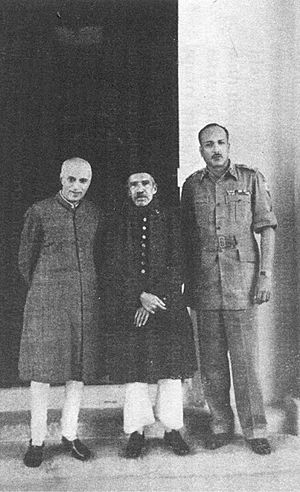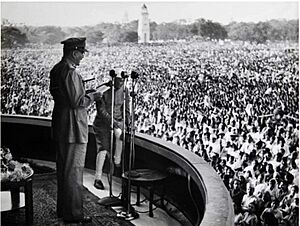Jayanto Nath Chaudhuri facts for kids
Quick facts for kids
General
J N Chaudhuri
|
|
|---|---|
 |
|
| 9th High Commissioner of India to Canada | |
| In office July 1966 – August 1969 |
|
| Preceded by | B. K. Acharya |
| Succeeded by | A.B. Bhadkamkar |
| 11th Chairman of the Chiefs of Staff Committee | |
| In office 3 March 1966 – 7 June 1966 |
|
| President | Sarvepalli Radhakrishnan |
| Prime Minister | Indira Gandhi |
| Preceded by | Bhaskar Sadashiv Soman |
| Succeeded by | Arjan Singh |
| 5th Chief of the Army Staff | |
| In office 20 November 1962 – 7 June 1966 |
|
| President | Sarvepalli Radhakrishnan |
| Prime Minister | Jawaharlal Nehru Gulzarilal Nanda (acting) Lal Bahadur Shastri Indira Gandhi |
| Preceded by | Pran Nath Thapar |
| Succeeded by | P. P. Kumaramangalam |
| Military Governor of Hyderabad State | |
| In office 17 September 1948 – 25 January 1950 |
|
| Preceded by | Office Established |
| Succeeded by | Mir Osman Ali Khan as Rajapramukh |
| Personal details | |
| Born | 10 June 1908 Chatmohar, Eastern Bengal and Assam, British India |
| Died | 6 April 1983 (aged 74) New Delhi, India |
| Alma mater | University of Calcutta Highgate School, London |
| Military career | |
| Nickname(s) | Muchhu |
| Allegiance | (1928–1947) (1947–1983) |
| Service/ |
(1928–1947) (1947–1966) |
| Years of service | 1928–1966 |
| Rank | General |
| Service number | IA-130 |
| Unit | 7th Light Cavalry 16 Light Cavalry |
| Commands held | Southern Army 1st Armoured Division 16 Light Cavalry |
| Battles/wars | Second World War
Indo-Pakistani War of 1947 Operation Polo Sino-Indian War of 1962 Indo-Pakistan War of 1965 Annexation of Goa |
| Awards | Padma Vibhushan Officer of the Order of the British Empire Order Of Merit (Arab Union) |
General Jayanto Nath Chaudhuri (June 10, 1908 – April 6, 1983) was a very important leader in the Indian Army. He served as the 5th Chief of Army Staff from 1962 to 1966. He was also the Military Governor of Hyderabad State from 1948 to 1949. After leaving the army, he became India's High Commissioner to Canada from 1966 to 1969.
Contents
Early Life and Family Connections
Jayanto Nath Chaudhuri was born into a well-known family in Bengal, British India. His family had many lawyers and writers. His grandfather, Durgadas Chaudhuri, was a landlord.
Interestingly, his grandmother, Sukumari Devi, was the sister of the famous Nobel Prize winner, Rabindranath Tagore. This means Rabindranath Tagore was his great-uncle! His mother, Pramila Chaudhuri, was the daughter of Womesh Chandra Bannerjee. Womesh Chandra Bannerjee was the first president of the Indian National Congress.
Many other family members were also successful. They worked in law, medicine, and writing. For example, his aunt, Devika Rani, was a famous Indian actress.
Education and Nickname
Chaudhuri started his schooling in Calcutta. He later studied at St. Xavier's College in India. He also went to Highgate School in London.
He then joined the Royal Military College, Sandhurst, a famous military school. It was here that he got his nickname, "Muchhu." This name means "moustache" because he had one! Ayub Khan, who later became President of Pakistan, was one of his classmates at Sandhurst.
Military Career Highlights
Starting His Army Journey
Jayanto Nath Chaudhuri officially joined the Indian Army as a second lieutenant in 1928. He first served with the 1st battalion North Staffordshire Regiment. Then, in 1929, he joined the 7th Light Cavalry.
He took special courses to improve his skills. These included an equitation (horse riding) course and a staff course.
World War II Service
In 1940, he went overseas as a major. He served in the Second World War in places like Sudan, Eritrea, Abyssinia, and the deserts of Africa. He was recognized for his brave service.
He received the OBE award in 1943 for his excellent work in the Middle East. Later, he commanded the 16th Light Cavalry in Burma from 1944 to 1945. He was again praised for his distinguished service there. After the Burma campaign, he also served in French Indochina and Java, Indonesia.
After India's Independence
After India became independent in 1947, Chaudhuri continued his important work. He helped with the military evacuation from Pakistan. He also helped organize India's efforts during the Kashmir war in 1948.
In May 1948, he took command of the 1st Armoured Division. This division played a big part in Operation Polo in 1948. This operation helped integrate Hyderabad State into India. After this, he became the Military Governor of Hyderabad State.


He held many other important army positions. He also led an Indian military group to China. By 1959, he was in charge of the Southern Command.
Leading the Indian Army
In 1962, after the Sino-Indian War, the Chief of Army Staff resigned. Jayanto Nath Chaudhuri took over as the acting Chief of Army Staff on November 20, 1962. He was officially appointed to the role in February 1963.
He was the Chief of Army Staff during the Indo-Pakistani War of 1965. This war is generally seen as a victory for India. He also helped create the Border Security Force. This force helps patrol India's borders during peacetime.
For his great service to the nation, he received the Padma Vibhushan. This is India's second-highest civilian honor. He retired from the army on June 7, 1966, after 38 years of service.
Diplomatic Role
After retiring from the army, Chaudhuri took on a new role. He was appointed as India's High Commissioner to Canada. He served in this important diplomatic position for three years, from 1966 to 1969.
Later Years and Lasting Impact
Chaudhuri wrote two books about military topics. He also reviewed books for a major Indian newspaper. He was the first Indian army chief to write his own life story, which he did in 1979.
He loved Western music. He even founded the Delhi Symphony Society, which promotes Western music. He was married to Karuna Chattopadhyay and they had two sons.
Jayanto Nath Chaudhuri passed away on April 6, 1983, in New Delhi. He was given a full military funeral. To honor him, the Border Security Force (BSF) gives an award each year. It's called the "GEN. J. N. Chaudhuri trophy" and is given to the best infantry battalion.
Awards and Decorations
| Padma Vibhushan | General Service Medal 1947 | ||
| Sainya Seva Medal | Indian Independence Medal | Officer of the Order of the British Empire (Military Division) | 1939–1945 Star |
| Burma Star | War Medal 1939–1945 | India Service Medal | Grand Cordon of the Order of Merit (United Arab Republic) |
Dates of Rank
| Insignia | Rank | Component | Date of rank |
|---|---|---|---|
| Second Lieutenant | British Indian Army | 2 February 1928 | |
| Lieutenant | British Indian Army | 2 May 1930 | |
| Captain | British Indian Army | 2 February 1937 | |
| Major | British Indian Army | 1940 (acting) 22 September 1941 (temporary) 8 February 1943 (war-substantive) 2 February 1945 (substantive) |
|
| Lieutenant-Colonel | British Indian Army | 22 September 1941 (acting) 8 February 1943 (temporary) 21 January 1946 (war-substantive) |
|
| Colonel | British Indian Army | 21 January 1946 (acting) | |
| Major | Indian Army | 15 August 1947 | |
| Major-General | Indian Army | February 1948 (acting) | |
| Brigadier | Indian Army | 21 January 1946 (acting) 1 January 1950 (substantive) |
|
| Brigadier | Indian Army | 26 January 1950 (recommissioning and change in insignia) | |
| Major General | Indian Army | January 1952 (substantive) | |
| Lieutenant General | Indian Army | 16 December 1955 (local) 8 May 1957 (substantive) |
|
| General (COAS) |
Indian Army | 20 November 1962 (acting) 20 July 1963 (substantive) |
See also


